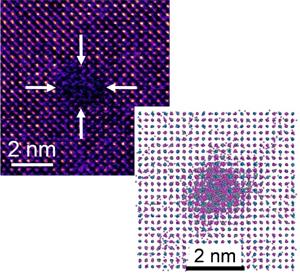
Upper left, a high angle annular dark field image is shown of an amorphous track produced by a 21 MeV Ni ion in SrTiO3 with pre-existing defects. Lower right, an atomistic simulation depicts the amorphous track formed by a 21 MeV Ni ion in SrTiO3 with defects.
A colossal synergy, orders of magnitude larger than anything previously reported, has been discovered to occur between electronic energy loss by ions and pre-existing atomic defects created by elastic energy loss in single-crystal strontium titanate (SrTiO3). This synergy results in the formation of nanometer-sized amorphous tracks, but only in the region with pre-existing defects. These defects decrease the electronic and atomic thermal conductivities and increase the electron-lattice coupling, which highly localizes the thermal spike for each ion, resulting in the formation of an amorphous track. This work identifies a major gap in fundamental understanding on the role of defects in electronic energy dissipation and electron-lattice coupling. As SrTiO3 is a foundational material in functional microelectronics, the work also provides new insights for creating novel interfaces and nanostructures to functionalize thin-film structures, including tunable electronic, magnetic and optical properties.
W. J. Weber, E. Zarkadoula, O. H. Pakarinen, R. Sachan, M. F. Chisholm, P. Liu, H. Xue, K. Jin, and Y. Zhang, “Synergy of elastic and inelastic energy loss on ion track formation in SrTiO3,” Scientific Reports 5, 7726 (2015). DOI: 10.1038/srep07726
For more information

